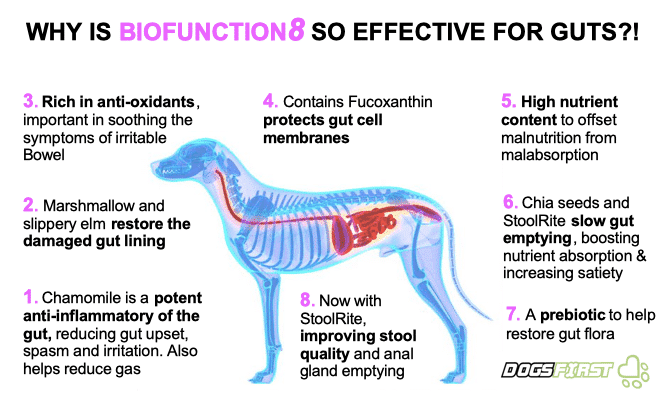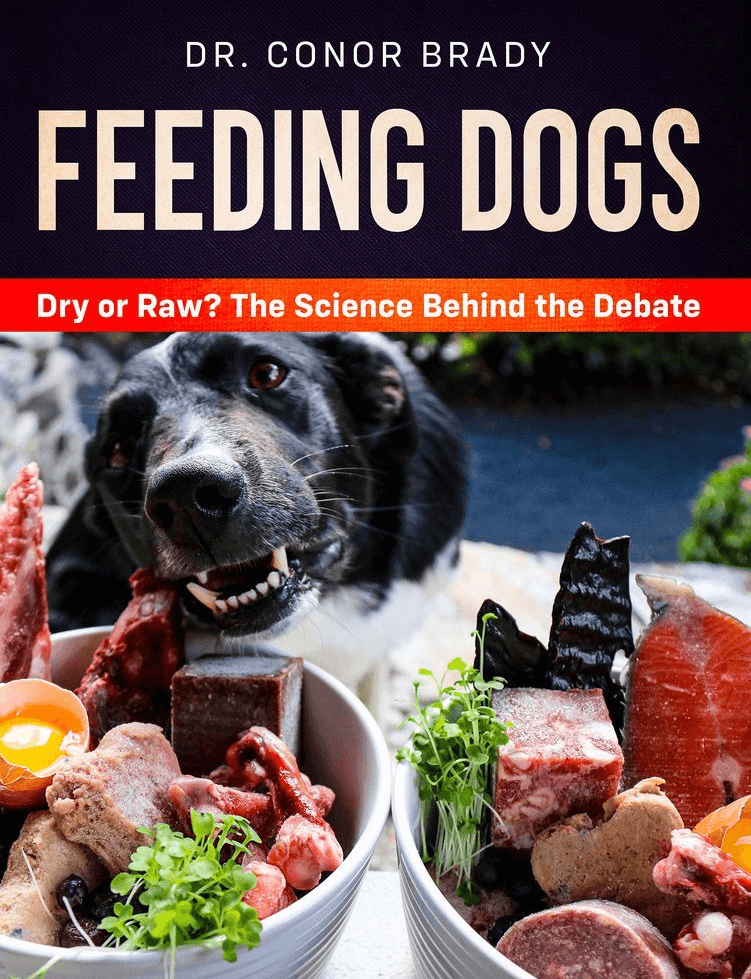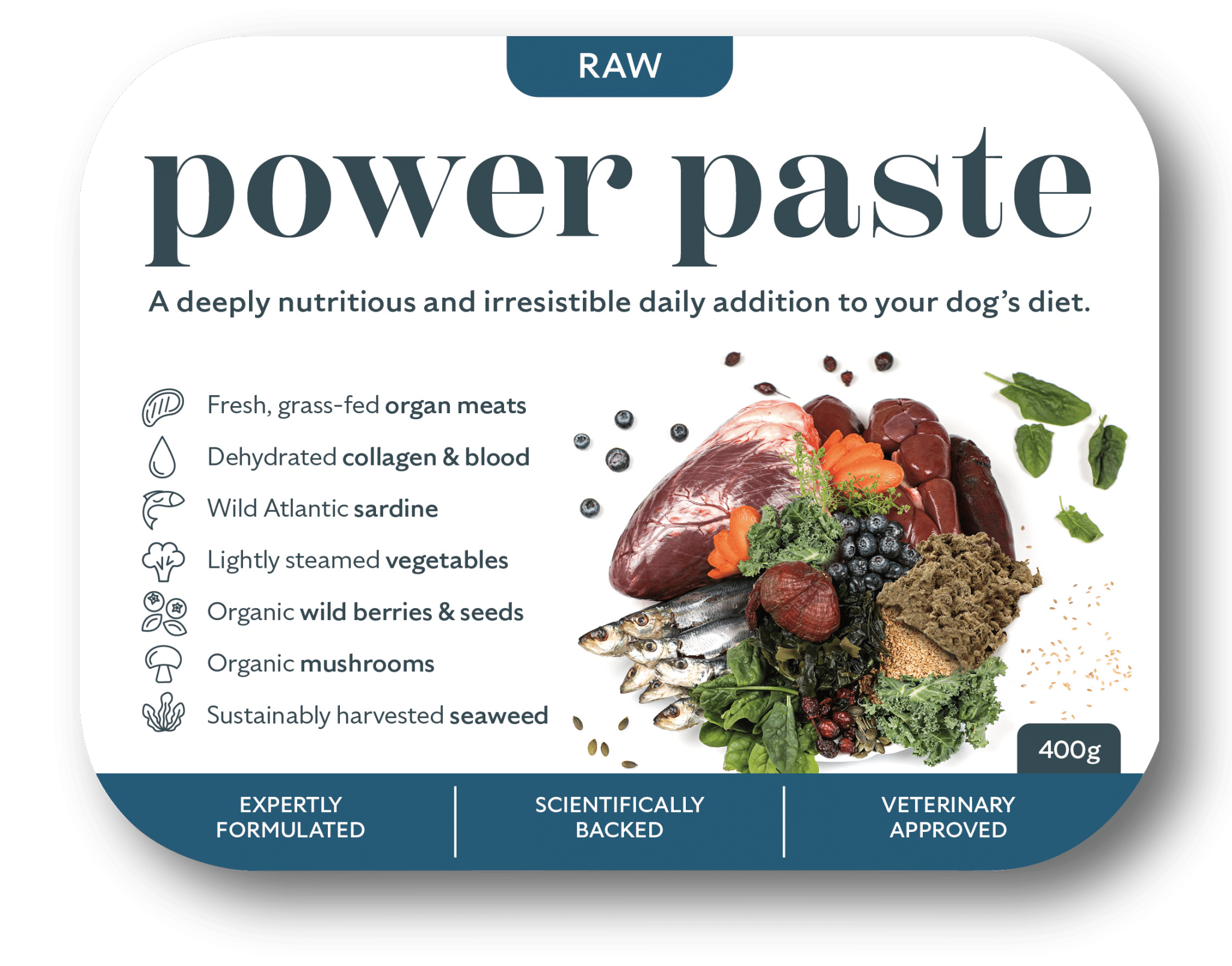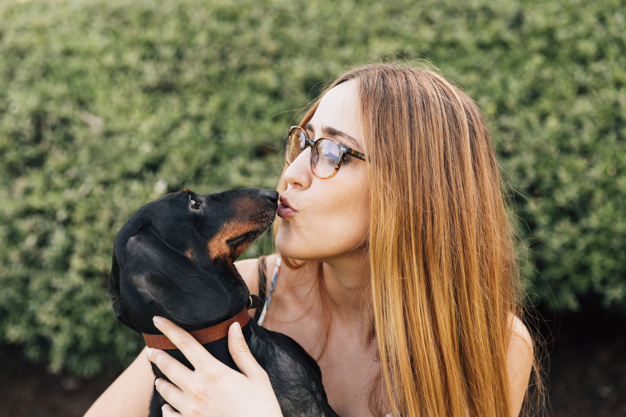Eight Reasons Why BioFunction8 Daily Will Help Alleviate the Symptoms of Gastrointestinal Disease in Dogs…
Before we start talking about adding anything IN to help gastrointestinal disease in dogs such as IBS or colitis type issues, you must first address the likely cause of their problems. In terms of the gut, it should come as no surprise that what you put into it is the key to good gut health. If your dog is gut sick or even if you have moved to raw and it hasn’t worked as well as you’d hoped, then please make sure you have read and fully digested (pardon the pun) our leading article on food allergies in dogs. It will explain to you the cause of the gastrointestinal disease in your dog and what you must do FIRST before you start wasting your time and cash and their health lobbing in supplements on top of a broken system. We must first ensure the diet is right, or at least as right as possible, before moving on to supplements such as BioFunction8, which are sure to put the finishing touches to a robust, perfectly functioning gut, to the very great health benefit of your pet.
That said, assuming the above has been considered, here are eight reasons why BioFunction8 alleviates gastrointestinal disease in dogs
1. Organic chamomile is a potent anti-inflammatory of the gut, reducing the symptoms of gastrointestinal disease in dogs, including gut upset, spasm and irritation. Also helps reduce gas, which is nice…

The main component of gastrointestinal disease in dogs is inflammation around the gut. It is this that requires immediate attention. This is where Chamomile comes in. Chamomile is one of the oldest medicinal herbs known to mankind. The flowers of Chamomile contain up to 2% volatile oil, which is made up of more than 120 secondary metabolites, including 28 terpenoids and 36 flavonoids, each one of potential benefit to you (should you fancy a delicious cup of tea, honestly, I highly recommend) or your dog (who can eat the flowers whole but ground). Traditionally, Chamomile has been used as an anti-inflammatory, antioxidant and in healing medicine and there are quite literally thousands of studies proving its efficacy. It has been used to treat a great variety of conditions in humans, from hay fever and general inflammation to muscle spasms, menstrual disorders, insomnia, rheumatic pain hemorrhoids, to reduce nerves or anxiety and the treatment of ulcers and wounds. Colossal literature reviews (where are all the studies are searched for and put together in a single summary article) by Miraj and Alasaedi (2016) and Srivastava et al. (2011) each using around 90 high quality studies, divide their literature review into many different health sections, citing the studies used to support the use of chamomile in each instance. It’s pretty impressive. Most importantly, at least for us here, is its efficacy as an anti-inflammatory of the skin and thus it’s excellent for gastrointestinal disease in dogs.
Chamomile is used traditionally for numerous gastrointestinal conditions, including digestive disorders, “spasm” or colic, upset stomach, flatulence (gas), ulcers, and gastrointestinal irritation.
Our Chamomile is organic, meaning it hasn’t been sprayed by herbicides or pesticides, which is really important in gut sick dogs whose gut flora is expected to be in complete disarray. Pesticides used to kill the bugs on plants will also kill the bugs in your gut that are trying to thrive on the food you are feeding them.
2. Gastrointestinal disease in dogs will damage the mucosal lining of the gut. Organic and sustainably harvested slippery elm and marshmallow, help repair it…
Slippery elm is a tree native to the United States and Canada although is now being grown in other countries, largely for medicinal benefits. It’s inner, reddish inner bark is slimy. Native Americans would harvest this substance from twigs and branches, mix it with water, creating a sticky compound that they would use to soothe a variety of many ailments, including sore throats (something the studies now support, somewhat unsurprisingly, and hence it’s recommended to be used in conjunction with echinacea in dogs suffering kennel cough) and wounds (American soldiers in the American Revolution found this particularly useful). They would even wrap the inner bark of the slippery elm around their meat to keep it from spoiling.
The secret to slippery elm, and indeed marshmallow, is that it functions as a mucoprotective agent (termed a demulcent)meaning it is capable of soothing the lining of the stomach and intestines and reducing irritation. Slippery elm has been used to ease the symptoms of IBS and Crohns in humans.
The problem with slippery elm is that less careful sources are destroying trees to harvest this incredible compound. So you need to be careful from where you source it. We use sustainably sources but it is fiercely priced so we couple a little slippery elm with marshmallow, a herb with all the same properties as slippery elm
3. BioFunction8 is rich in antioxidants, protecting cell membranes and soothing the symptoms of irritable bowel…
Inflammation and cell membrane now on the fix, we need to solidify the defences and ability of the gut to repair itself with some antioxidants. A growing body of evidence is now linking oxidative stress to irritable bowel syndrome. Oxidative stress is an imbalance between roaming reactive oxygen species (free radicles) and the system’s ability to readily detoxify them, alleviating any damage that might ensue. This is where the word “detox” comes from, though folk use it in too many situations where it often does not apply. The bottom line is, the more natural forms of antioxidants you get from your food, the better (within reason!). I think it’s important to note free radicles are not always bad, your immune system depends on them for example, they use them to hunt and destroy invaders, but in media free radicles are often the baddies where a preponderance in the body, say from eating too much bad fat and ultra-processed food or not enough antioxidants, result in cells suffering serious damage and death. All sorts of health issues for the animal, most famously playing key roles in ageing and cancer but here we are focusing on the gut.
Seaweeds contain an array of antioxidants commonly found in land plants, such as carotenoids and flavonoids, but also a whole host of unbelievably effective antioxidant compounds that only exist below the waves. Brown algae contain alginates, sulphated fucose-containing polymers and laminarin; red algae contain agars, carrageenans and porphyrans; and green algae contain xylans and sulphated galactans. Many contain a mix of all these compounds. I mean, check out how many studies prove seaweed is effective in the fight against cancer!
Chia seeds too contain more than their share of antioxidants. A myriad of studies show that chia seeds contain high antioxidant content (see Taga et al. 1984 and Martínez-Cruz and Paredes-López 2014).

4. BioFunction8 contains a unique seaweed extract high in Fucoxanthin which studies show protects gut cell membranes…
Clearly, we are obsessed about seaweed. Did you know there are more seaweeds under the ocean than herbs on the planet? They are a completely untapped resource. We have teamed up with a marine scientist with 30 years experience in the field of seaweeds to bring you an array of seaweed-based products, including Irish Kelp for Dogs (this is true Kelp, Laminaria digitata), Oculus Prime for Weepy Eyes and AC4 which should assist (we have to be very careful here) your dog’s fight against cancer. More popularly, we are the proud creators of the ever-popular StoolRite which we now have begun to include in BioFunction8 too (see below). We have written many times about the amazing benefits of seaweeds, for longer articles on these amazing see the articles below. But below we provide a summary of why we use certain seaweeds in BioFunctio8.
- Why seaweeds are an incredible daily supplement for your dog
- A note on when to use seaweeds and when you mightn’t.

As the numerous testimonials elude to, our seaweed products are highly effective, hence they come with a money-back guarantee. The secret to the success of our seaweed products is that we are very picky where are seaweed comes from. We use only Irish where possible unless the species we need is not found naturally in our waters. We only use sustainable sources, never stuff that has been dredged off the seabed (such as in Norway, very damaging to the environments) or off the beach where it can go bad. In particular, we do not use seaweed dried with temperature. This destroys the bioactive polysaccharides in the plant which have all the benefit. However, it’s a much cheaper way to produce dried seaweed so guess which one is most commonly available?!
Many nutrients and bioactive polysaccharides (sugars) in plants like to be cooked hence none of the truly medicinal herbal products are heat treated. In particular, for gastrointestinal disease in dogs, we are concerned about the fucoxanthin, which is entirely unique to seaweed. Studies show fucoxanthin protects gut cell membranes. This is vital in gut sick dogs who are sheathing away great quantities of gut cell membranes with recurring gastrointestinal upset. Our unique seaweed extract is high in fucoxanthin and is used in BioFunction8 for this purpose.
5. Gastrointestinal disease in dogs will result in gradual malnutrition from malabsorption. The high nutrient content of BioFunction8 offsets this…
When a gut works well and the gut flora are in balance and happily working away, you digest and absorb all you need from a good diet. However, when gut-sick one likely side effect is malnutrition. It simply can’t do the job it is designed to do properly, leading to a slow, chronic process termed malnutrition through malabsorption. It is for this reason, a nice injection of nutrients is a very good idea for gastrointestinal disease in dogs
Seaweeds are often just eaten for their nutrient potential. It concentrates minerals from seawater and this results in a nutrient content 10–20 times that of land plants (Makker et al. 2016), helped by the fact it suffers none of the soil erosion issues. This boost of vitamins and minerals is something gut-sick dogs will very much be in need of while their digestion and absorption have been interrupted.
Chia seeds too play a role here. They are packed with harder to find minerals such as magnesium and manganese. This is crucial for raw fed dogs where raw diets can be deficient in manganese.
6. Both chia seeds and now StoolRite help to slow gut emptying, certainly increasing satiety and hopefully boosting nutrient absorption…
There’s no point wasting great food and added nutrients if your gut isn’t even getting a chance to pick the good stuff out. To aid this process we take two approaches, one is to reduce inflammation and repair the gut (below) but in the very short term, we can slow the passage of the digesta through the gut, giving the troubled gut more time working on it.
Studies show the fibre in seaweed may slow stomach emptying times. Chia seeds too do this. Studies show the high soluble fibre content of chia seeds can absorb up to 10–12 times their weight in water, becoming gel-like and expanding in your stomach. This should slow the passage of digesta, hopefully giving their gut more time to get at the good stuff out as well as helping your poor dog feel fuller for longer. It is likely this “fuller for longer” trait of some seaweeds (such as the ones we use BioFunction8), coupled with certain phenolic compounds present in the plant, are the reasons why studies show seaweed is shown to be effective in the fight against obesity, at least in rats and now humans. Similarly, eating chia seeds for breakfast is known to increase satiety and reduced food intake in humans, at least in the short-term.
But the fibre content of these two ingredients, chia seeds and the seaweeds used in BioFunction8, have another benefit to guts, and that’s benefiting the gut flora…
7. BioFunction8 is a prebiotic that will likely help restore gut flora…
[Probiotics are your gut flora. Prebiotics are essentially the food they need to eat].
Gastrointestinal disease in dogs will leave their gut flora in total disarray and this can play havoc with many aspects of their health (for more see our in-depth article “everything you need to know about canine probiotics“). Sugars found in seaweed called sulfated polysaccharides have been shown to increase the growth of “good” gut bacteria, at least in humans. These polysaccharides can also increase the production of short-chain fatty acids (SCFA), which provide support and nourishment to the cells lining your gut).
Fibre too helps this process. With 40% fibre content, chia seeds are one of the best sources of fibre out there and this fibre is good news for the gut flora. Together with StoolRite fibre, this will help get the gut flora get back in balance.
At this point, some of the real canine nutrition nuts might be asking, is plant fibre and generally lessons learned from human nutrition applicable to this meat-eating animal who would have a different gut flora to ours? Well, that question certainly struck me too. Here’s a segment from my forthcoming book Raw Science tackling exactly, for all non-nerds, feel free and skip to the summary below!
In terms of modulating the canine GI microbiota, complex carbohydrates and dietary fibre-based prebiotics (in other words, plant-based prebiotics) have been the major nutritional strategies studied thus far. Fructans, including chicory root extract, inulin, oligofructose, and short-chain fructooligosaccharides (scFOS) have been studied in greater detail in dogs than other ingredients with prebiotic potential. Both chicory and beet pulp have been found to alter the dog’s gut bacteria increasing faecal bifidobacteria and lowering faecal clostridia. When Apanavicius et al. (2007) deliberately infected 12wk old pups fed prebiotics (namely 1% scFOS and 1% inulin, a.k.a. soluble plant fibre, the stuff that makes chia seeds absorb all the water) they found those receiving the prebiotics suffered less enterocyte (cells of the gut wall) sloughing, had higher total Short Chain Fatty Acid (SCFA) concentrations and a greater faecal content of Lactobacilli. Gagne et al. 2013 reduced diarrhoea in sled dogs with a mixture of nutrients and plant-based prebiotics.
So human-type pre and probiotics seem to be well worth a go. But authors note there are too few clinical experiments performed to actually test the ability of dietary fibre and prebiotics to promote gut and overall health in dogs (Hooda et al. 2012) only an array of gut health indicators have been assessed, including faecal scores, pH, microbiota, and fermentation end-products. In other words, we’re still not quite sure what the long-term health benefits of these pre and probiotics might be. A recent study of fruit flies pushed this conundrum further. A recent study of fruit flies reveals that gut microbes can influence what we feel we need to eat. They found that when fruit flies were purposefully left short on some dietary amino acids they will naturally crave certain foods to top those levels up, as you would expect. But, when these protein-hungry flies are given more gut microbes of two certain types, the microbes can actually switch off this craving in the fly and direct the animal towards more sugar, which they need, effectively demonstrating a bottom-up pathway of communication of nutritional needs for the first time.
As we know raw-fed dogs display a different microbial profile to omnivorous humans and dry-fed dogs, there is great scope here to investigate more carnivore-friendly prebiotics, whatever they may be and Kumar et al. (2017) are the first to have looked into this in greater detail. They divided Labradors into three groups. One was fed a basal diet without probiotic (control), the second, a diet with added probiotic of canine origin (Lactobacillus johnsonii) and the third received a diet containing a probiotic of dairy origin (Lactobacillus acidophilus). Overall, they found that the canine-origin probiotic was superior when compared with the dairy-origin probiotic. The reason for this, perhaps unsurprisingly, is that dogs are not plant eaters. Their gut flora is different.
In summary, this implies that while yes, the best canine probiotics are engineered with the requirements of this meat-eating animal in mind. But it follows that the best prebiotics too are meat-based. However, all humans have really investigated are plant-based prebiotics, many of which actually seem to be beneficial to dogs, which is a touch confusing but good news for now. This subject needs much more research. For now, we know that meat peptides can act as a prebiotic (at least in human babies) so it’s likely when you follow our advice at the top of the article and move the dog to raw dog food, they will be inadvertently be getting a nice whack of meat-based prebiotics in there. However, if we are going to exclude many more normal sources of fibre for the carnivorous dog (indigestible ingredients such as hair, teeth, hide) for now we must take the bit of good news above and exploit the likes of chia seeds and seaweed for their fibre contents, if just for the short term, to the immediate benefit of your gut-sick dog.
8. Gastrointestinal disease in dogs will result in poor stools and often anal gland issues. BioFunction8 now includes a pinch of StoolRite, a leading natural solution to these issues…
Most of you are now aware of our popular seaweed fibre supplement StoolRite. It’s unique, gluten-free, high fibre content a means it can make hard poos soft and soft poos firmer. I know, it sounds like something Harry Potter makes but it’s really just the role the types of fibre present in StoolRite play in the digestive process, sucking water into the stool like a sponge. It means this product is highly effective in the treatment of BOTH constipation and diarrhoea.
More importantly here, when you couple this particular fibre content with StoolRite’s anti-inflammatory properties, this product becomes one of the leading natural solutions for anal gland issues in dogs. Multiple review sites now testify to it’s efficacy in this regard, for instance, check out the reviews it is receiving on Frank n Jellys for exactly this issue (4.7 stars from 11 reviews, and the one that didn’t give it five stars it helped anyway!).
BioFuncion8 5 Stars!
Wonderful, wonderful product. What a difference it made to my dogs gut health. My working cocker would sometimes produce loose stool, and I started him on this a week ago. The difference is incredible. Much better stool, a big difference. Started my other dog on it as well, and both of them have definitely improved, perfect bowel function. Will certainly be buying it from now on.
B. Lawson 06/19/2018













